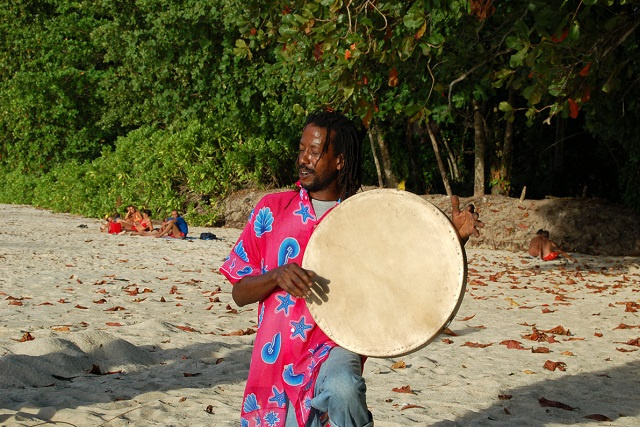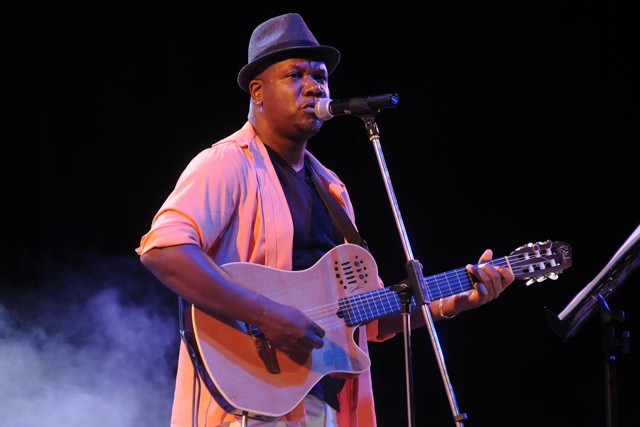Artist radiates pride over Moutya music, asks Seychelles to embrace it more

The Moutya drum is made of goatskin and is tuned by heating it by the campfire. (Gerard Larose)
(Seychelles News Agency) - Seychellois artist Jean-Marc Volcy built his career on promoting the traditional music of Seychelles among which is the Moutya, which was added to UNESCO's list of intangible heritage in November.
Volcy was among a group of artists working towards obtaining international recognition for the island nation's traditional music.
SNA met with Volcy now that Moutya is on UNESCO's list to hear his thoughts and reaction.
SNA: How do you feel now that Moutya is being recognised internationally?
JMV: I feel a sense of pride but I believe the authorities have to thank all those who over the years have been working hard to promote Moutya locally. If they had not been making the effort, it would have been hard for UNESCO to give it the recognition it just has.
The people who have really worked on the genre are the younger artists like Channel Kilindo, Piston and Norville Ernesta. These are the ones who have really taken what they have known about the Moutya and run with it. The country owes them a big thank you for the role they have played.
If they had not sung, UNESCO would not have given us this recognition. Let's be honest we were not living Moutya at some point.
SNA: How have you helped promote Moutya and what has it brought you?
JMV: I have played Moutya on my guitar, the accordion and other instruments that I use to perform, and this is what has made me Jean-Marc Volcy. It not only brought me fame but it has also given me my way of life. I have nurtured Moutya and in turn, it has taken good care of me.
I took this part of my culture to Europe, Africa and I have even performed it in Argentina. I believe this has brought me to ask where can we take our culture? Not the other way round.
 |
| Volcy said he has played Moutya on his guitar, the accordion and other instruments that he uses to perform. (Seychelles Nation) Photo License: CC-BY |
SNA: How do you feel about the thinking that Moutya is not living because there are no longer authentic drums being made, with the required goat's skin?
JMV: This is an excuse. I say this because our next door neighbour, Mauritius, has a Moutya drum industry. They have them in all sizes over there. Many times I've seen tourists buying a drum to take with them as a souvenir when I was over there. How many Seychellois can say they bought a drum while they were there? This is why I say this is an excuse.
Most of the things we consume in this country is imported so why can't we import Moutya drums or better yet why not import the goat's skin. I myself own about four Moutya drums that I bought in Mauritius.
It is important to buy the drums as Moutya is an industry. If you rear goats for their skin, you will not only sell the skin but also the meat. Meanwhile, the drum will be sold and we can also make small replicas that may be used as souvenirs of Seychelles. It presents limitless opportunities.
The music itself can be recorded so that people may enjoy it during a small gathering. If such events are held in all the districts, this would create jobs. Our culture, in general, is an industry, it's a shame that not much effort has been put into promoting it as such.
SNA: Now that Moutya has been recognised, are you and other artists taking steps to ensure the genre is given more prominence?
JMV: Fondasyon Kiltir Seselwa (Foundation for Seychellois Culture) is a new foundation that has been established comprising some well-known local artists and local cultural figures. The aim of the foundation is to make people understand our culture.
We must all help to safeguard what makes us who we are. If we don't do that, we will always be drifting and we will always be hearing different music, seeing different dress styles that we will be leaning towards without protecting what is really ours. If we don't preserve our own culture, we will forget who we are.
When that happens what will we be selling to visitors, American culture, Jamaican culture or Hip Hop? This is not our culture and visitors who come to Seychelles do so to experience the Seychellois culture. They want to know who we are as a people packaged in our beautiful sea and greenery. They want to know how we cook, dance and live with each other; this is what we must preserve. This is the type of work FKS will be undertaking.
SNA: What is your favourite Moutya song?
JMV: I like all Moutya songs as soon as the beat of the drums hit, it transforms me and puts me in a good mood. There are many songs that I like some of them are ones that I have performed myself such as 'Kannon', one that talks about a man who had been working in the outer islands and had not been in the company of a lady for 18 months.
'Dan mon pos napa larzan' (there's no money in my pocket) is another one I like because it talks about how when I have money the lady claims I smell of perfume but as soon as I am broke, the lady says I smell awful.
The songs have real messages in them. They talk about the realities of life on the island and the situations that our people have gone through. People are often disinterested in the songs because they make them think of bad times, but bad times are a fact of life.
SNA: Do you believe that the topics being addressed in the songs are out of touch with today's problems and hence not interesting to the youths?
JMV: I think the youths are not interested in Moutya because they have not been properly exposed and educated about it. Culture is not taught in schools here. How can young people associate themselves with Moutya if they don't know what it's about?
This is why the journey to transmit cultural knowledge should begin in schools. When this is done, our youths will be able to know who they are, especially now that other cultures are readily available to the young through their mobile phones.
The influences they get through their laptops, television and radio is much more than the knowledge we are giving them. This is why I believe we must teach all the aspects of their Seychellois culture and not only Moutya.
Although I have learnt through the activities Seymas held some six years ago, that the youth enjoy Moutya, they are the first ones to come to the front of the stage to dance. It is in their blood, after all, it is just that they are not getting it which makes it dormant.





